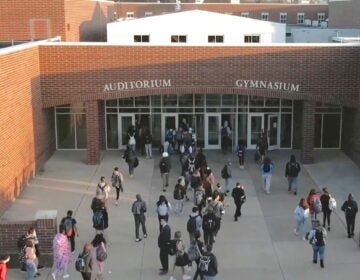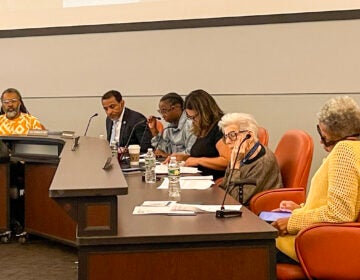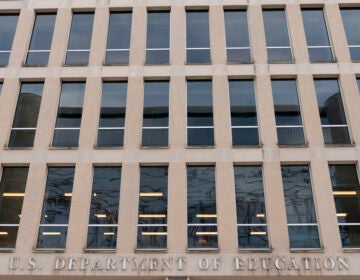Why kindergarten? Pandemic disruption forces big questions about U.S. education system
Kindergarten attendance is down during the pandemic. Is that a good thing? A bad thing? Science and history offer some answers.
Listen 13:22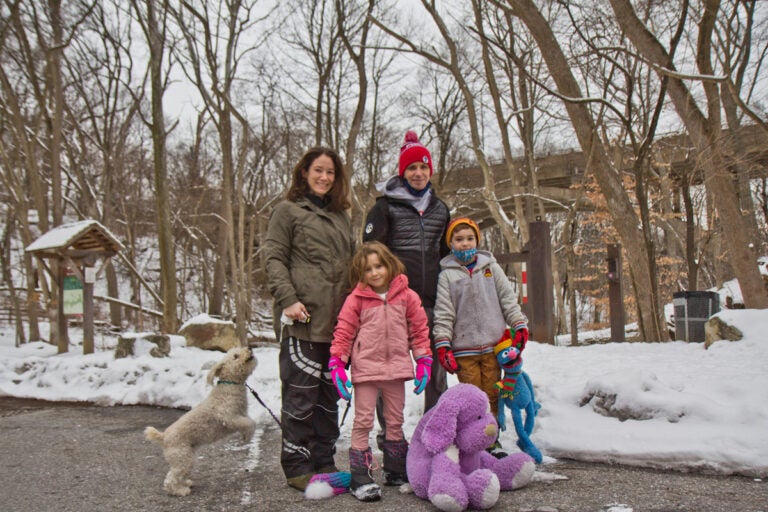
Rachael and Phil Reilly with their children Winnie, 6, and Caden, 8, and dog Rosie, before taking a walk along the Wissahickon Creek in Philadelphia, Pa. (Kimberly Paynter/WHYY)
This story is from The Pulse, a weekly health and science podcast.
Subscribe on Apple Podcasts, Spotify or wherever you get your podcasts.
Phil Reilly is part of an accidental educational movement.
Each weekday morning, he rises in his Northwest Philadelphia home, reads the paper, drinks a little tea, and plans a few lessons for his daughter Winnie, who recently turned six. She’s in kindergarten — kind of.
Like an unusually large number of kids her age, Winnie did not enroll in kindergarten this year. Turned off by virtual school and the uncertainty surrounding COVID-19, Winnie’s family decided to homeschool her informally.
For a few hours each morning, Reilly guides Winnie through math, reading, and social studies lessons.
“We can really knock out school in, to be honest, two hours,” Reilly said. He is also homeschooling his second-grade son this year.
The afternoons are reserved for stories and play dates and neighborhood strolls.
“They’re out — even in the cold — just out playing and being kids and going for a walk and hiking and running around the field and just having fun and learning that way,” Reilly said.
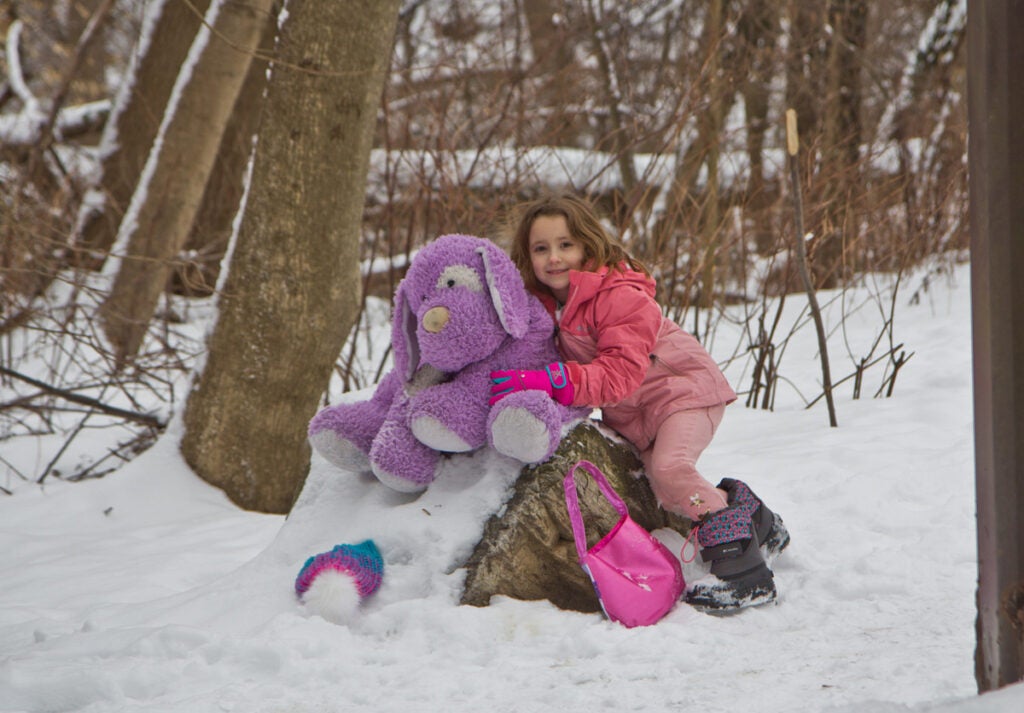
This year, there are more families like the Reillys than usual.
Although there are no official, national numbers yet, public school enrollment appears to have fallen significantly this year. Most notably, fewer kids are attending kindergarten. In Pennsylvania, kindergarten enrollment dipped nearly 4% — about twice as large as the overall enrollment decline.
The pandemic is likely the culprit.
According to federal data, 32 states, Pennsylvania included, didn’t require kindergarten as of 2018. Faced with the prospect of virtual school, hybrid school, or a restricted in-person experience, thousands of families have simply said: No thanks. We’ll wait until next year.
“I was like, ‘I can teach them,’” Reilly said. “Rather than let them sit in front of a computer for anywhere from 4 to 6 hours.”
The shockwave of the pandemic has caused many sectors and industries to reexamine what had before seemed to be obvious defaults.
Almost a year after widespread shutdowns in the U.S., the education system is among those assessing long-held assumptions with fresh eyes.
One of them is kindergarten.
Why do we have this grade named after a German word? Why is it the first rung on the ladder that is our formal education system? And why does that ladder begin around age 5?
The answer to these questions begins over 180 years ago.
A Prussian revolution
Prussian pedagogue Friedrich Froebel invented the idea of kindergarten in 1837.
The term literally means “garden of children,” and Froebel envisioned it as a place where children could blossom into young people.
“It was a very distinctive educational model, focused on promoting young children’s spiritual and moral development,” said Jennifer Lin Russell, a University of Pittsburgh professor who studies educational policy and has written about the evolution of kindergarten.
Froebel felt that kids learn through self-discovery and play. The teacher doesn’t drill knowledge into children. The teacher creates conditions for children to teach themselves.
This original kindergarten was, as Russell puts it, “a fairly prescriptive” model of education. Froebel laid out specific daily sequences that kindergarten instruction should follow.
You started the day with songs. Froebel even wrote a book of songs for teachers and children to sing together. Then after songs, Froebel expected children to move to play. He invented sets of wooden toys in various shapes that he called “gifts,” hoping they would facilitate creativity.
The kindergarten concept migrated to America along with German immigrants. The first American kindergarten opened for German speakers in Watertown, Wisconsin in 1856.
Stateside education reformers soon caught hold of the concept. One of them was Elizabeth Peabody, sister-in-law to public school evangelist Horace Mann (and famed novelist Nathaniel Hawthorne).
Peabody founded America’s first English-speaking kindergarten in Boston in 1860. The idea spread quickly among progressive reformers, sprouting independent kindergartens across the country.
“It was really almost a social movement,” Russell said. “[Kindergarten pioneers] promoted kindergarten as a distinct form from traditional schooling — with this focus on play, flexible physical environments, lots of outside activities, and very deliberately the exclusion of traditional academic subjects.”
Reformers saw kindergarten as a way to redefine children — to see them not just as the exploited young laborers of the Industrial Revolution, but as young souls with intellectual and moral capabilities.
“This was part of the transition of thinking of young childhood as this special, protected time,” Russell said.
The new first grade
Kindergartens began as independent entities, but reformers wanted to scale up. They needed a way to tap into the infrastructure and public dollars dedicated to America’s growing public school system.
“The way to do it was to link [kindergarten] to elementary schools,” Russell said.
And so kindergarten slowly got tacked onto the bottom of the elementary school ladder.
Subscribe to The Pulse
This process took decades. By the mid-1960s, still only about half of states offered funding for kindergarten programs. The final growth spurt took place over the next decade, according to a study by Dartmouth economist Elizabeth Cascio. Many states — especially in the South and West — saw kindergarten as a way to ultimately save money.
“[States thought] this is going to reduce grade repetition where we have to pay for a kid to go through this grade twice,” Cascio said.
By the latter half of the 20th century, the K-12 school system had been largely established.
This melding of kindergarten with the broader education system led to a kind of natural merger. By virtue of being in the same buildings and under the same administrative auspices, kindergartens naturally became more academic.
External forces also played a role.
In the later part of the 20th century and into the 21st, school systems adopted new accountability measures based on standardized tests. Suddenly, a school’s reputation — or even existence — could be tied to the reading scores of third-grade students. That created pressure to focus on academics as early as possible.
“Districts started to see kindergarten as a way to jumpstart learning and these foundational skills,” Russell said, who has tracked the way kindergarten changed over the end of the 20th century.
One study looked just at changes to kindergarten between 1998 and 2010 and found eye-opening shifts. Over just those dozen years, kindergarten teachers became far more likely to expect their students to read by the end of the year, far more likely to administer standardized tests, and less likely to spend time on music and art. And these changes were most drastic in schools serving high proportions of low-income children and children of color — the same schools often subject to the most scrutiny around standardized test scores.
“Overall, our results suggest that public school kindergarten classrooms became increasingly similar in structure and focus to typical first-grade classrooms,” the researchers wrote.
But when should school begin?
Kindergarten has changed since its inception — rather radically.
But the changes have been driven largely by social pressures and expectations, not changes in scientific research.
Cognitive science does not offer a binary answer on when children should enter a formal, academic environment.
“There’s nothing magic about the age of five or six that suddenly turns a switch in children’s brains, where all of a sudden it’s like, ‘Yes, I’m ready for school,” said Melissa Libertus, a University of Pittsburgh professor who studies cognitive development in young children.
Scientists believe that babies start learning the building blocks of reading and math from almost the moment they enter the world, Libertus said.
A tiny infant can distinguish human speech from other sounds. When scientists play a string of words for three-month olds, they can see activity in the part of the brain that processes language, according to Libertus. When they play that speech backward, the same section of the brain does not activate.
The same goes for basic quantitative activities. The youngest kids understand concepts of less and more.
These lingual and numeral instincts — they’re in us. What we call language and math are systems of symbols — codes — that allow us to express this latent knowledge.
“All that these numbers and symbols and math allow us to do is to be more precise in our calculations — to say, ‘Oh, it’s exactly three. It’s exactly 10,’” Libertus said.
School, as we know it, is the place where we take these instincts and we learn how they match up with the human codes we’ve invented. That leads to a core question:
“When do you start introducing kids to these formal systems,” asked Libertus. “And why?”
There’s no simple answer.
Some kids make these connections early. Some require more time and more specific kinds of training — for instance, those with dyslexia or its mathematical equivalent, dyscalculia.
Then there’s the social element.
When are kids ready to do what we now call kindergarten? When are they ready to sit at a desk? Or listen to a teacher? Or play nice with friends?
“What often happens is when kids are not ready for it they often start having negative experiences in school,” Libertus said. “And that just spirals out of control over time.”
The reason kids tend to start kindergarten around the same age doesn’t emerge from the world of cognitive science. It’s based in administrative and social pragmatism. Running a system any other way would be unwieldy.
The system isn’t set up to gauge when kids are actually ready for academic schooling.
Stanford economist Thomas Dee and some colleagues tried to better understand that question by using data from Denmark.
They looked at kids who started kindergarten really close to age 5 and those who started really close to age 6.
On the whole, they found that the late starters had some advantages, but they were limited to certain areas.
“We saw uniquely large benefits in terms of reducing inattention and hyperactivity,” Dee said.
Before the pandemic there was already a movement among some parents to delay their kids’ entry into kindergarten — partly because of an assumption that it would give them a leg up academically. It’s unclear if it actually does.
What Dee found is that there may be some non-academic benefits to delaying. But does that mean a kid should delay kindergarten? Or maybe even consider skipping it altogether?
It depends on whether they’re struggling to self-regulate. And it depends on how regimented their kindergarten is, Dee said.
Original kindergarten
There is evidence that targeted early childhood programs — like Head Start and other forms of Pre-K — can provide a crucial boost that lasts with kids for a lifetime.
But when American kindergarten became near-universal in the 1960s and 70s, evidence showed little effect on long-term outcomes like high school graduation, college attendance, and likelihood of incarceration, according to Elizabeth Cascio’s research.
That’s something to keep in mind now, as we try to predict how this unusually large cohort of kindergarten skippers and delayers will fare. If record numbers of families are opting to postpone entry into formal school right now, the best we can say is this: It could be good for some. Not so much for others.
There’s already worrying signs that young students — especially those from disadvantaged backgrounds — are falling behind during the pandemic. And many families don’t have the money or flexibility to homeschool their children.

Phil Reilly knows he’s in a better position than most. He has a flexible schedule as a cross-country coach and a degree in elementary education.
Still, he sometimes worries that he’s doing the wrong thing for his kids’ development.
“Every now and then I’ll be like, ‘Oh, crap. What if they go back to the school and I messed up and they’re not ready,’” Reilly said.
But he quickly gets over it. He notes that Winnie’s become a stronger reader this year. She’s counting through 100, something she couldn’t do before. She’s hitting all the academic benchmarks.
Meanwhile, she’s spending less time on academics and more time in play.
When she goes to first-grade next year she will have officially “skipped” kindergarten.
But her experience sounds more like what kindergarten used to be.
WHYY is your source for fact-based, in-depth journalism and information. As a nonprofit organization, we rely on financial support from readers like you. Please give today.





